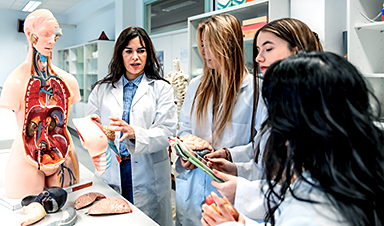Nanotechnology, Nanomedicine, and AI: Toward the Dream of Global Health Care Equivalency

![]()
“Progress in medicine, global access to information and a global age pyramid that is already turning upside-down will increase the demand for good health care. This in turn will increase life expectancy and drive innovation. This re-enforcing circle will change societies’ views on health care. Whereas today it is seen as a cost that needs to be controlled — which slows down progress — it might become the global driving force of innovation and humanity, replacing other areas of public investment focus.”
Harald Stock, President & CEO, ArjoHuntleigh
Introduction
We are very fortunate indeed to be living at a time where the speed of advances in medical technologies is such that we can expect to live increasingly healthier and longer lives; far beyond what would ever have been imagined as possible only a century ago. However, in contrast to our natural inalienable human rights to life, liberty, and the pursuit of happiness, our equally important right to good health (and by extension good health care), which is critical for all of us, is unfortunately either in disarray, dysfunctional, or completely neglected on a global scale.
The State of Health Care Today
A news item released on December 2017, by the World Health Organization (WHO) entitled: “World Bank and WHO: Half the world lacks access to essential health services, 100 million still pushed into extreme poverty because of health expenses”, reported that “800 million people spend at least 10 percent of their household budgets on health expenses for themselves, a sick child or other family member. For almost 100 million people these expenses are high enough to push them into extreme poverty, forcing them to survive on just $1.90 or less a day.” A 2017 report authored by Dr. Margaret Chan (Director-General, WHO) stated that “Nearly 2 billion people have no access to basic medicines, causing a cascade of preventable misery and suffering.” The current state of affairs in the developed world for those who are fortunate enough to have access to medical care, in some cases includes the burden of $1000 per dose, and from $100,000 to $1.21 million per year in individual drug expenditures alone.
What is Global Health Care Equivalency (GHCE)?
Looking ahead over the next 10-30 years, with the rapid emergence of, and synergies between, the disciplines of nanotechnology, nanomedicine, and AI, we can envisage a future world where any individual on the planet has access to the same advanced and cost effective nanomedical diagnostic and therapeutic technologies, no matter how wealthy or impoverished they are, no matter where they happen to reside, or under what conditions they live. Progress toward this goal will be incremental, with each successive wave of nanomedical technologies being more advanced than the previous wave. The tipping point will arrive with the emergence of Molecular Manufacturing (MM), http://ieet.org/index.php/IEET/more/boehm20160115, which will make possible the cost effective fabrication of the classes of advanced autonomous nanomedical devices that Boehm describes in his first book: Nanomedical Device and Systems Design: Challenges, Possibilities, Visions. A situation may then well arise where the entire human population will finally come to realize the inalienable human right of optimal health for life through the establishment of a worldwide health care system under the moniker: “Global Health Care Equivalency” (GHCE). The details and vision for GHCE will be articulated in an upcoming book: Nanotechnology, Nanomedicine, and AI: Toward the Dream of Global Health Care Equivalency that is currently being generated by the originator of this concept (Frank Boehm – CEO of NanoApps Medical Incorporated) in collaboration with numerous thought leading authors.
Perceived Benefits of GHCE
The attainment of GHCE might serve to significantly reduce the perception of individuals in the developing world of being marginalized, at least in terms of health care, which may ultimately translate to conflict reduction. In the developed world, GHCE would serve to dramatically reduce health care expenditures across the board. Progress toward this goal will be incremental, with each successive wave of nanomedical technologies being more advanced than the previous wave. The tipping point will arrive with the emergence of Molecular Manufacturing (MM), http://ieet.org/index.php/IEET/more/boehm20160115, which will make possible the cost effective fabrication of the types of advanced autonomous nanomedical devices that Boehm describes in his first book: Nanomedical Device and Systems Design: Challenges, Possibilities, Visions.
It is worth noting here that all nations on a global scale stand to benefit immensely when their citizens are healthy, as they would save hundreds of millions, if not billions of dollars in health-related expenditures, not to mention lost work hours and overall productivity, due to illness and its associated incapacities.
The core essence of GHCE is aptly conveyed in the thought below:
“In a world facing considerable uncertainty, international health development is a unifying – and uplifting – force for the good of humanity.”
Dr Chan, WHO Director-General
What is Molecular Manufacturing (MM)
The first mention of the possibility of MM emerged through the words of Dr. Richard Feynman in 1959, via his famous talk, “Plenty of Room at the Bottom”, where he spoke of the possibility of the controlled manipulation of matter at the atomic level. Dr. Eric Drexler described the remarkable capabilities that he envisioned for a conceptual molecular assembler in his 1986 book, Engines of Creation. In 2003, Chris Phoenix generated a paper that articulated the Design of a Primitive Nanofactory. Dr. Robert Freitas Jr. et al., have extensively investigated Diamond MechanoSynthesis and personalized Nanofactories from 2002 to the present.
Once MM is developed, it will have the capacity to fabricate just about any consumer item or food, as well as advanced autonomous nanomedical robots from elemental atoms and molecules, guided by AI-driven specifications. By virtue of these fundamental feed stocks, it will likely become very cost effective to fabricate (physician prescribed) nanomedical devices to address virtually any condition that ails us, in one’s own home, via Factory@Home (F@H) units, which might be manifest as countertop microwave-sized appliances that are extensively distributed worldwide. Concurrently, home based atomic and molecular “disassembly” units would be able to completely recycle, sort, and repackage practically any type of material according to its specific atomic and molecular species, which could again be used to supply the F@H units for fabrication.
Awaking the Dream
Although the attainment of GHCE would indeed be a truly extraordinary achievement, we must keenly recognize that in reality, such a massive undertaking on a global scale will require intense and sustained high spirited collaboration between like minded individuals who have widely varied backgrounds within diverse areas of expertise. Highly specialized laboratories, dynamic administrative institutions, regulatory bodies, and government agencies worldwide will also be vital prerequisites for its realization, as will significant resources and time. We are all amazing individuals, each with our own unique talents and expertise that might contribute and be applied to this noble enterprise. Our working together might culminate in a positive critical mass on a global scale toward the actual realization of GHCE, which would ultimately be of benefit for each and every one of us, as we are finally “all” supported in our natural human right of optimal health for life.
News
Repurposed drugs could calm the immune system’s response to nanomedicine
An international study led by researchers at the University of Colorado Anschutz Medical Campus has identified a promising strategy to enhance the safety of nanomedicines, advanced therapies often used in cancer and vaccine treatments, [...]
Nano-Enhanced Hydrogel Strategies for Cartilage Repair
A recent article in Engineering describes the development of a protein-based nanocomposite hydrogel designed to deliver two therapeutic agents—dexamethasone (Dex) and kartogenin (KGN)—to support cartilage repair. The hydrogel is engineered to modulate immune responses and promote [...]
New Cancer Drug Blocks Tumors Without Debilitating Side Effects
A new drug targets RAS-PI3Kα pathways without harmful side effects. It was developed using high-performance computing and AI. A new cancer drug candidate, developed through a collaboration between Lawrence Livermore National Laboratory (LLNL), BridgeBio Oncology [...]
Scientists Are Pretty Close to Replicating the First Thing That Ever Lived
For 400 million years, a leading hypothesis claims, Earth was an “RNA World,” meaning that life must’ve first replicated from RNA before the arrival of proteins and DNA. Unfortunately, scientists have failed to find [...]
Why ‘Peniaphobia’ Is Exploding Among Young People (And Why We Should Be Concerned)
An insidious illness is taking hold among a growing proportion of young people. Little known to the general public, peniaphobia—the fear of becoming poor—is gaining ground among teens and young adults. Discover the causes [...]
Team finds flawed data in recent study relevant to coronavirus antiviral development
The COVID pandemic illustrated how urgently we need antiviral medications capable of treating coronavirus infections. To aid this effort, researchers quickly homed in on part of SARS-CoV-2's molecular structure known as the NiRAN domain—an [...]
Drug-Coated Neural Implants Reduce Immune Rejection
Summary: A new study shows that coating neural prosthetic implants with the anti-inflammatory drug dexamethasone helps reduce the body’s immune response and scar tissue formation. This strategy enhances the long-term performance and stability of electrodes [...]
Scientists discover cancer-fighting bacteria that ‘soak up’ forever chemicals in the body
A family of healthy bacteria may help 'soak up' toxic forever chemicals in the body, warding off their cancerous effects. Forever chemicals, also known as PFAS (per- and polyfluoroalkyl substances), are toxic chemicals that [...]
Johns Hopkins Researchers Uncover a New Way To Kill Cancer Cells
A new study reveals that blocking ribosomal RNA production rewires cancer cell behavior and could help treat genetically unstable tumors. Researchers at the Johns Hopkins Kimmel Cancer Center and the Department of Radiation Oncology and Molecular [...]
AI matches doctors in mapping lung tumors for radiation therapy
In radiation therapy, precision can save lives. Oncologists must carefully map the size and location of a tumor before delivering high-dose radiation to destroy cancer cells while sparing healthy tissue. But this process, called [...]
Scientists Finally “See” Key Protein That Controls Inflammation
Researchers used advanced microscopy to uncover important protein structures. For the first time, two important protein structures in the human body are being visualized, thanks in part to cutting-edge technology at the University of [...]
AI tool detects 9 types of dementia from a single brain scan
Mayo Clinic researchers have developed a new artificial intelligence (AI) tool that helps clinicians identify brain activity patterns linked to nine types of dementia, including Alzheimer's disease, using a single, widely available scan—a transformative [...]
Is plastic packaging putting more than just food on your plate?
New research reveals that common food packaging and utensils can shed microscopic plastics into our food, prompting urgent calls for stricter testing and updated regulations to protect public health. Beyond microplastics: The analysis intentionally [...]
Aging Spreads Through the Bloodstream
Summary: New research reveals that aging isn’t just a local cellular process—it can spread throughout the body via the bloodstream. A redox-sensitive protein called ReHMGB1, secreted by senescent cells, was found to trigger aging features [...]
AI and nanomedicine find rare biomarkers for prostrate cancer and atherosclerosis
Imagine a stadium packed with 75,000 fans, all wearing green and white jerseys—except one person in a solid green shirt. Finding that person would be tough. That's how hard it is for scientists to [...]
Are Pesticides Breeding the Next Pandemic? Experts Warn of Fungal Superbugs
Fungicides used in agriculture have been linked to an increase in resistance to antifungal drugs in both humans and animals. Fungal infections are on the rise, and two UC Davis infectious disease experts, Dr. George Thompson [...]















